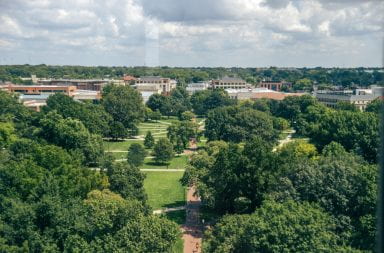Coming home from class, some students are welcomed by the sweet aroma of a home-cooked meal. The glistening of the furniture tells the tale of a good spring cleaning while sounds of girlish giggles fill the air. It’s home sweet home at the Alumnae Scholarship Houses.
The Hanley, Pomerene and Fechko Houses, all located on south campus, are a part of the Alumnae Scholarship Housing Program.
The program has offered this unique, low-cost housing option for women at Ohio State for more than six decades.
“It’s a residence hall but the set up is a house. Unlike the ‘res halls’ where you can walk in the hallway by a floor mate and not say anything, here it’s hard to just ignore everyone,” said Laura Carter, a junior in political science and dance and the resident adviser of Hanley House. “It’s so much closer than in a dorm. It’s a lot more comfortable.”
The women of the house, in exchange for reduced housing fees, do their own house cleaning and cooking. With the help of their food manager, the women are sectioned into pairs or small groups, and are given dinner assignments four days out of the week.
House cleaning chores are designated to the residents, and one Saturday a month there is an “all house cleaning” when the women spend the entire day cleaning the house top to bottom.
More than one thousand women have participated in the program, and are actively involved in fund-raising or mentoring the program’s current students.
“One time we made blankets for a community service project. We also have started having annual spring break trips where we do a lot of community service as well as see the sights in the city,” said Illaina Euvrard, a professional veterinary student and five-year resident of the Alumnae Scholarship Houses.
With approximately 15-19 women in each house, the homes foster more close-knit relationships between the women, a quality that can be overlooked in the more traditional-style residence halls where there can be as many as 70 students assigned to one floor.
“From a (resident adviser) perspective, it’s a more intimate experience of living in the house with fewer residents,” said Abbie Anderson, a senior in strategic communications and RA for Fechko House.
Last school year, Anderson was an RA in the Bradley-Patterson Complex.
“It’s easier to develop stronger one-on-one relationships with the girls,” Anderson said.
These stronger relationships last for years to come.
“We have alumnae who come back years later with their kids, just to show them where their mother lived in college,” said Kristyn Biebuyck, hall director for the Alumnae Scholarship Housing Program.
All residents of the three houses in the program come together for annual programs such as the Homecoming Parade Walk and Spring Break Trip. They also participate in the Fall Welcome, which is a formal welcome given by the advisory board every fall. Alumnae come to meet the new women in the program and give them Alumnae Scholarship Housing Program gifts, such as tote bags and photo albums.
The ASH program ends each year with a Woman of the Year banquet at the Longaberger Center. The banquet recognizes scholarship recipients of the year as well as the Woman of the Year for each house. It also gives the women of the houses the opportunity to connect with alumnae and end the year on a positive note.
The residents also celebrate Thanksgiving together.
“We get to invite our families and friends from back home to our Thanksgiving which is really fun. We’re all like family,” Euvrard said.
Another tradition is the semi-daily house dinners. Monday through Thursday, a few women of the house are assigned “dinner duty” and are called on to prepare that night’s meal. Preparations usually begin around 4 p.m. every afternoon so that dinner can be served promptly at 6 p.m.
“The girls are familiar with the dinner schedule so there are usually about 8-10 people at dinner every night. It’s not mandatory for the girls to attend dinner, but it’s real nice. It definitely makes for a more homier feeling,” Carter said.
The houses are set up in a traditional home setup, with a basement and three levels of rooms. On the first level there is the living room, kitchen and a triple bedroom. There is usually only one triple, with a few single rooms and the rest doubles. The rooms are furnished with the standard residence hall beds and armoires.
The fact that the housing placement is built on a financial-need scholarship, which is partly funded by alumnae, creates a connection in the house that goes beyond graduation years.
“There is so much opportunity to remain connected to the program, through mentorship and visits after graduation. It’s a tremendous experience,” Biebuyck said. “I can’t say enough good things about it.”


